Review Article Open Access
Role of Gymnema sylvestre as Alternative Medicine
| Lalit Kishore, Navpreet Kaur and Randhir Singh* | |
| M.M. College of Pharmacy, Maharishi Markandeshwar University, Mullana, Ambala, Haryana, 133207-India | |
| Corresponding Author : | Randhir Singh M.M. College of Pharmacy Maharishi Markandeshwar University Mullana, Ambala, Haryana, India Tel: +91- 80509930172 E-mail: randhirsingh.dahiya@gmail.com |
| Received October 14, 2014; Accepted December 08, 2014; Published December 29, 2014 | |
| Citation: Kishore L, Kaur N, Singh R (2015) Role of Gymnema sylvestre as Alternative Medicine. J Homeop Ayurv Med 3:172. doi: 10.4172/2167-1206.1000172 | |
| Copyright: ©2015 Kishore L, et al. This is an open-access article distributed under the terms of the Creative Commons Attribution License, which permits unrestricted use, distribution, and reproduction in any medium, provided the original author and source are credited. | |
Visit for more related articles at Journal of Traditional Medicine & Clinical Naturopathy
Abstract
Context: Gymnema sylvestre R.Br, belonging to the family Asclepiadaceae, has been employed to control diabetes, obesity, atherosclerosis etc., by traditional medicinal practitioners of India for nearly two millennia. The active principals from the leaf extracts is assumed to be gymnemic acid and its derivatives which are of triterpenoids in chemical nature have the ability to renew the islet cell mass for the possible cure of diabetes. Objective: The present review deals with botanical description, chemical constituents, and pharmacological effect of the plant using herbal and homeopathic medicine from the past to recent developments. Methods: Scientific databases including SCOPUS, PUBMED, SCIELO, NISCAIR, and Google Scholar were used to retrieve articles and only relevant studies published in English were considered. Results: This paper gives an overview of G. sylvestre from antiquity to till date. There is sufficient evidence of pharmacological and phytochemical studies to draw a definite conclusion about the efficacy of the gymnemic acid for the treatment of diabetes and obesity but, there is still inadequate literature related to other activities. The reported studies on the effect of G. sylvestre as homeopathic medicine are not sufficient. Therefore further studies are needed to explore the role of G. sylvestre in homeopathy. Conclusion: There is still a dire need to explore the mechanism of action of G. sylvestre, toxicity profile and to determine its role as alternative medicine.
| Keywords |
| Gymnema sylvestre, Diabetes, Homeopathy, Ayurveda |
| Introduction |
| The use of plants as medicine is as old as human civilization. Renewed interest of developing as well as developed countries in the natural resources has opened new horizons for the exploration of natural sources with the perspectives of safety and efficacy. Herbal drugs, in India are also used as household remedy for common ailments since time immemorial. The plant Gymnema sylvestreR. Br. (Asclepiadaceae) is a vine which grows in the southern part of China, including the Guangdong, Guangxi and Fujian provinces. G. sylvestre occurs mainly in the Deccan peninsula of western India, Tropical Africa, Vietnam, Malaysia, and Srilanka and is widely available in Japan, Germany and the USA as a health food [1]. The plant extracts are also used in folk, Ayurvedic and Homeopathic systems of medicine [2]. G. sylvestre is a traditional medicinal plant, with reported use as a remedy for diabetes mellitus, stomachic and diuretic problems. |
| Traditionally its use has been indicated in adenopathy, cough [3], asthma, biliousness, bronchosis, cardiopathy, conjunctivosis, cornea, diabetes, dysuria, fever, furunculosis, glycosuria, hemorrhoid, inflammation, leukoderma, opacities, ophthalmia, and worm [4]. The roots of Gymnema sylvestre has also been used in snake bite [5]; boil, constipation, and water retention [6]; epilepsy, pain [7]; high cholesterol, IDDM, NIDDM and obesity [8]. The extract of G. sylvestre plays a major role in blood glucose homeostasis through increased serum insulin level and regeneration of the endocrine pancreas [9]. Within the last 10 years, a number of Gymnema products including Gymnema capsules, Gymnema tea, Bioshape®, Diaxinol®, Body Slatto Tea®, Gymnema®, Gymnema Diet®, Sugar Off®, GlucosetTM , Cinndrome XTM , and PilisoftTM have appeared on the world market [10]. |
| The principle of Homoeopathy has been known since the time of Hippocrates from Greece, the founder of medicine, around 450 B.C. Homoeopathy as it is practiced today was evolved by the German physician, Dr. Samuel Hahnemann (1755–1843). The word ‘Homoeopathy’ is derived from two Greek words, ‘Homois’ meaning similar and ‘pathos’ meaning suffering. Homoeopathy simply means treating diseases with remedies, which are capable of producing symptoms similar to the disease when taken by healthy people [11]. |
| In Gymnema species a number of phytochemical constituents have been reported by several authors. Its constituents include two resins, gymnemic acids, saponins, stigmasterol, quercitol and the amino acid derivative of betaine, choline and trim ethylamine, but its main active compound is gymnemic acid, saponins and oleanane type of triterpenoid [12]. G. sylvestrecontains oleanane type triterpene (Gymnemagenin) and gymnemic acid which itself is not pure entity, but composed of 4 components, A1 - A4, with gymnemic acid A1 as the predominant one [13]. Gymnemagenin and gymnestogenin were isolated and crystallized by Stocklin in 1968, who reported the isolation of a new compound gymnemic acid A1, which could be converted to gymnemic acid A2 [14], but gymnemic acid A-D were reported in different forms [15]. Yoshikawa and co-workers [16,17] isolated gymnemic acids from the hot water extract of G. sylvestredry leaves, which they named gymnemic acids I, II, III, IV, V, VI and VII (compound 1-7) respectively (Figure 1). In contrast, the next series of anti-sweet compounds, Gymnema saponins I, II, III, IV, and V were isolated from G. sylvestre [18]. Further work carried out in G. sylvestre led to isolate and characterization of other gymnemic acids VIII, IX, X, XI, XII, XIII, XIV, XV, XVI, XVII and XVIII (Compound 8-18, Figure 1) [19-22]. |
| Ye et al. [1] isolated six new oleanane saponins along with two known oleonolic acids (Figure 2), 28-O- β-D-glucopyranosyl ester and oleanolic acid 3-O- β-D-glucopyranosyl (1→6) - β-D -glucopyranoside. New Oleanane saponins were characterized as longispinogenin 3-O-β-D-glucuronopyranoside (19), 21β- benzoylsitakisogenin 3-O-β-D-glucuronopyranoside (20), 3-O-β-D-glucopyranosyl[1→6]- β-D-glucopyranosyl oleanolic acid 28-O-β-D-glucopyranosyl ester (21), 3-O-β-D-xylopyranosyl[1→6]-β-D-glucopyranosyl[1→6]- β-D-glucopyranoside (22), 3-O-β-D- xylopyranosyl [1→6]-β-Dglucopyranosyl[ 1→6]-β-D-glucopyranosyl oleanolic acid 28-O-β- D-glucopyranosyl ester (23) and 3-O-β-D-glucopyranosyl[1→6]-β- D-glucopyranosyl oleanolic acid 28-β-D-glucopyranosyl[1→6]-β-Dglucopyranosyl ester(24). Ye et al. [23] further isolated new saponins which were identified as 21-β-O-benzoylsitakisogenin 3-O-beta-Dglucopyranosyl( 1→3)- β -D-glucuronopyranoside (25), the potassium salt of longispinogenin 3-O- β -D-glucopyranosyl (1→3)- β -D-gluc- uronopyranoside (26) and its aglycon gymnemagenol, was characterized as 3 β,16 β,28, 29-tetrahydroxyolean-12-ene (27) (Figure 3) were isolated from an ethanol extract of the leaves of G. sylvestre [23]. Two new oleanane-type triterpenoid saponins (Figure 4), gymnemoside-W1 (28) and W2 (29) [24] and the flavonoid triglyceride (Figure 5), kaempferol 3-O-β-D-glucopyranosyl-(1→4)-alpha-L-rhamnopyranosyl- (1→6)-β-D-galactopyranoside (30) were also isolated from G. sylvestre [25]. Oleanane type triterpenoid saponin (Figure 5), dihydroxy gymne- mic triacetate (31) was derived from the acetone extract of G. sylvestre [26]. Liu et al. [27] isolated a new triterpenoid saponin, the sodium salt of 22α-hydroxyl-longispinogenin 3-O-β-D-glucuronopyranosyl-28-O- α-L-rhamnop yranoside. |
| Keeping in view extensive traditional uses of G. sylvestre a comprehensive search of the literature was conducted to identify the best available evidence on G. sylvestre. Scientific databases including SCOPUS, PUBMED, SCIELO, NISCAIR, and Google Scholar were used to retrieve articles and only relevant studies published in English were considered. The search included (i) the reported animal studies on the pharmacological effect of G. sylvestre (ii) randomized clinical trials on G. sylvestre using herbal and homeopathic preparations. |
| Role of Gymnema sylvestre in ayurveda supported by experimental and clinical studies |
| Plants and plant-derived products are part of health care system since ancient human civilizations. The need of new chemical entities for health care is explored and served through the plant sources. Evolution of Ayurveda and plant-based remedies for health care through dayto- day life experiences is a part of cultural heritage of India. The World Health Organization (WHO) estimates that about 80% of the population living in the developing countries relies on traditional medicine for their primary health care needs [28]. In almost all the traditional systems of medicine, the medicinal plants play a major role and constitute their backbone. Indian Materia Medica includes about 2000 drugs of natural origin almost all of which are derived from different traditional systems and folklore practices [29]. G. sylvestre have numerous pharmacological activities reported by several authors and many experiments were carried out on G. sylvestre (Figure 6). |
| Antidiabetic activity: G. sylvestre can be useful in certain cases of non-insulin dependent diabetes as it reduces serum glucose concentration and improves glucose tolerance [30]. Administration of leaf extract of G. sylvestre (120 mg/kg/ day p.o.) for 7 days in STZ induced rats reduced amylase activity in serum, increased β-cell function, regenerated β-cells in pancreatic islets and showed higher levels of serum C-peptide [31]. The beneficial effect was observed in oral treatment to cure Non-Insulin Dependent Diabetes Mellitus (NIDDM) to use the 400 mg/kg of leaf extract, where there is a significant reduction of blood glucose, glycosylated hemoglobin and plasma protein and increase in serum insulin levels Shanmugasundaram et al. [31]. In another study on patients with type 2 diabetes, G. sylvestre leaf extract at a dose of 400 mg/day was administered for 18-20 months as a supplement to the conventional oral drugs, regenerated β-cells and raised insulin level in serum of the patients [31]. Chattopadhyay [32] explained that the possible mechanism behind the antihyperglycemic effect of G. sylvestre leaf extract is its potential to enhance insulin secretion. The G. sylvestre alcoholic extract also stimulates insulin secretion from rat islets of Langerhans and several pancreatic β-cells lines [33]. |
| Sugihara et al. [34] investigated Gymnemic acid IV and observed that it increased plasma insulin levels which contributed to the antihyperglycemic effect by the leaves of G. sylvestre. Om Santal Adivasi (OSA®), a high molecular weight fraction isolated from G. sylvestre leaf extract, reversibly stimulates insulin secretion from isolated human islets and its insulin secretagogue effects in MIN6 cells and human islets were partially dependent on the presence of extracellular Ca2+ . These data indicate that low concentrations of the G. sylvestre isolate OSA stimulate insulin secretion in vitro, at least in part as a consequence Ca2+ influx, without compromising β-cell viability [35,36]. OSA® is effective in reducing blood glucose and increasing plasma insulin and C-peptide levels in humans. In vitro studies suggest that at least some of these effects of OSA® can be attributed to a direct stimulatory effect on insulin secretion from β-cells in the islets of Langerhans [37,38]. |
| An active compound dihydroxy gymnemic triacetate has been isolated from G. sylvestre acetone extract. Dihydroxy gymnemic triacetate (20 mg/kg body weight) was orally administered for 45 days to streptozotocin diabetic rats for the assessment of plasma glucose, insulin, glycated hemoglobin (HbA1c), and tissue glycogen and lipid parameters. It produced significant effects on all biochemical parameters studied, indicating that dihydroxy gymnemic triacetate possessed hypoglycemic and hypolipidemic activity in long-term treatment and hence it could be used as a drug for treating diabetes [26]. An open label study was conducted on the supplementation of G. sylvestre in type 2 diabetic patients for a period of 3 months. Supplementation of the diet with G. sylvestre reduced polyphagia, fatigue, blood glucose (fasting and post-prandial), and glycated hemoglobin and there was a favorable shift in lipid profiles and in other clinico-biochemical tests suggesting a beneficial effect of G. sylvestre in the management of diabetes mellitus [39]. The gymnemic acid of leaf and callus extracts significantly increases the regeneration of β-cells in treated rats, when compared with the standard diabetic rats. It could have potential as a pharmaceutical drug for insulin-dependent diabetes mellitus (IDDM). Feeding G. sylvestre leaf extract to the diabetic rats decreased the activity of glutathione peroxidase in cytosolic liver and glutamate pyruvate transaminase in serum to normal levels, reducing oxidative stress in diabetic rats [40]. Deacyl gymnemic acid isolated from G. sylvestre produces a significant decrease in insulin resistance accompanied with a decrease in systolic blood pressure and improves glucose and lipid profile without decreasing body weight in a rat model of metabolic syndrome [41]. G. sylvestre significantly increase plasma active GLP- 1 levels, thus producing hypoglycemic effect via DPP-IV inhibition [42]. Saponins, 3-O-β-D-glucuronopyranosyl-21-O-2-tigloyl-22-O- 2-tigloyl Gymnemagenin and 3-O-β-D-glucuronopyranosyl-21-O- 2-methylbutyryl-22-O-2-tigloyl Gymnemagenin, isolated from G. sylvestre inhibited sodium-dependent glucose transporter 1 (SGLT1) thereby acting as potential antidiabetic agents by inhibiting glucose uptake from gastrointestinal tract [43]. |
| Hypolipidemic and atherosclerotic activity |
| Obesity plays a central role in the insulin resistance syndrome, which is associated with hyperinsulinemia, hypertension, hyperlipidemia, type 2 diabetes mellitus, and an increased risk of atherosclerotic cardiovascular disease. Obesity is the main consequence from the accumulation of the carbohydrates and fats. A randomized, doubleblind, placebo-controlled human study was conducted in Elluru, India for 8 weeks in 60 moderately obese subjects (ages 21-50, BMI >26 kg/m (2)). G. sylvestre extract along with (-)-hydroxycitric acid and niacinbound chromium serve as an effective and safe weight-loss formula by facilitating reduction in excess body weight and body mass index [44]. Gymnemic acids curb the binding of carbohydrates to the receptors in the intestine and hence, the “empty calories” are taken care of so that the body does not go into obese stage. Gymnemic acids are also useful in curbing of diabetes by a similar mechanism [45]. Assessment of effect of G. sylvestre extract in the high fat diet-induced cellular obesity demonstrated that it causes significant reversal of increased body mass index, organ weights and visceral fat pad weight. The possible mechanism for an anti-obesity effect of G. sylvestre extract may be via suppression of levels of leptin, insulin, dyslipidemia, apolipoproteins, lipids, visceral fat pad weights, and oxidative stress in obese rats fed with high fat diet [46]. Saponin-rich fraction of G. sylvestre aqueous leaf extract possess anti-obese action as it significantly decreases the body weight, food consumption, visceral organs weight, and the levels of triglycerides, total cholesterol, low-density lipoproteins, very low-density lipoproteins, atherogenic index, glucose, and increases the levels of high-density lipoproteins [47]. The anti-obesity effect of water soluble fraction of G. sylvestre extract (120 mg/kg, p.o. for 21 days) in high fat diet fed rats. It reduces body weight gain, food intake, serum lipids, leptin, insulin, glucose, apolipoproteins A1 and B, lactate dehydrogenase levels and increases HDL and antioxidant enzymes level. Study concluded that G. sylvestre extract possess antiobesity effect [48]. Bishayee and Chatterjee studied hypolipidemic and atherosclerotic effects of G. sylvestre leaf extract and observed that at a dose of 25-100 mg/kg G. sylvestre leaf extract reduced lipid level and increased serum HDL and antiatherogenic index [49]. |
| Antimicrobial activity |
| The ethanolic extract of Gymnema sylvestreleaves demonstrated antimicrobial activity against Bacillus pumilis, B. subtilis, Pseudomonas aeruginosa and Staphylococcus aureus and inactive against Proteus vulgaris and Escherichia coli providing justification for the use of the plant in folk medicine to treat various infection disorders [50]. Candida albicans is an opportunistic and polymorphic fungal pathogen that causes mucosal, disseminated and invasive infections in humans. The triterpenoid saponin family of gymnemic acids is inhibitor of C. albicans morphogenesis. Purified gymnemic acids had no effect on the growth and viability of C. albicans yeast cells but inhibited its yeast-tohypha conversion under several hypha-inducing conditions, including the presence of serum [51]. G. sylvestrepossess larvicidal activity against the Japanese Encephalitis vector, Culex tritaeniorynchus and thus can be used as an important component in the Vector control Programme [52]. |
| Anticancer activity |
| Ethanolic extract of Gymnema sylvestre leaves have significant anticancer effect on A375 cells. It induces nuclear DNA fragmentation and shows an increase level of mRNA expression of apoptotic signal related genes cytochrome c, caspase 3, PARP, Bax, and reduces expression level of ICAD, EGFR, and the anti-apoptotic gene Bcl2 indicating the possibility of its palliative use in cancer patients [53]. |
| Anti-inflammatory activity |
| The aqueous extract of G. sylvestre leaves was investigated for evaluation of anti-inflammatory activity in rats at a dose 200, 300 and 500 mg/kg in carrageenan-induced paw oedema and cotton pellet method. The aqueous extract at the dose of 200 mg/kg and 300 mg/kg produced significant reduction in granuloma weight, when compared to control group. |
| Antioxidant activity |
| In vitro, the inhibitory effects of DPPH radicals and LDL oxidation were found with aqueous extract of G. sylvestre. G. sylvestrerequire 32.1 μl, for scavenging 50% of the DPPH radicals [54]. |
| Role of Gymnema sylvestrein Homeopathy |
| In homoeopathy, a drug obtained from the leaves and roots of G.sylvestre is prescribed for both diabetes mellitus and insipid us. A multicentric, double-blind, randomized homeopathic pathogenetic trial was conducted on G. sylvestre. The drug was proved in two potencies (6C and 30C) on 63 apparently healthy volunteers who were selected after conducting pre-trial medical examination by the medical specialists and routine laboratory investigations. In the first phase volunteers were given 56 doses (4 doses per day for 14 days) of placebo. In the next two phases 56 doses (4 doses per day for 14 days) of each potency or placebo were consumed. This drug seems to be useful in clinical conditions such as headache, vertigo, common cold, cough, diarrhea, etc. Further, work is necessary to find out the real value of the drug in diabetes (Figure 6) [55,56]. |
| Conclusion |
| Ayurveda practice continues today to treat human diseases and provides positive health benefits to the people. Considering the widespread use and popularity of Ayurveda, proper standardization and validation method are being developed for promoting Ayurvedic drugs. G. sylvestre is a multipurpose potential medicinal plant having high market potential all over the world. In case of herbal medicinal plants, there is sufficient evidence of pharmacological and phytochemical studies to draw a definite conclusion about the efficacy of the G. sylvestre for the treatment of diabetes and obesity, though there is still inadequate literature related to other activities. But, the reported studies on the effect of G. sylvestre as homeopathic medicine are not sufficient. The use of G. sylvestre mentioned in homeopathic system of medicine should be explored in the form of preclinical and clinical data for various ailments, with the modern scientific approaches for better leads in the health care. Furthermore, in future study, the isolated principals from G. sylvestre needs to be evaluated in scientific manner using various innovative experimental models and clinical trials for better understanding of its mechanism of action, so that its therapeutic uses can be widely explored as alternative medicine. |
References
|
Figures at a glance
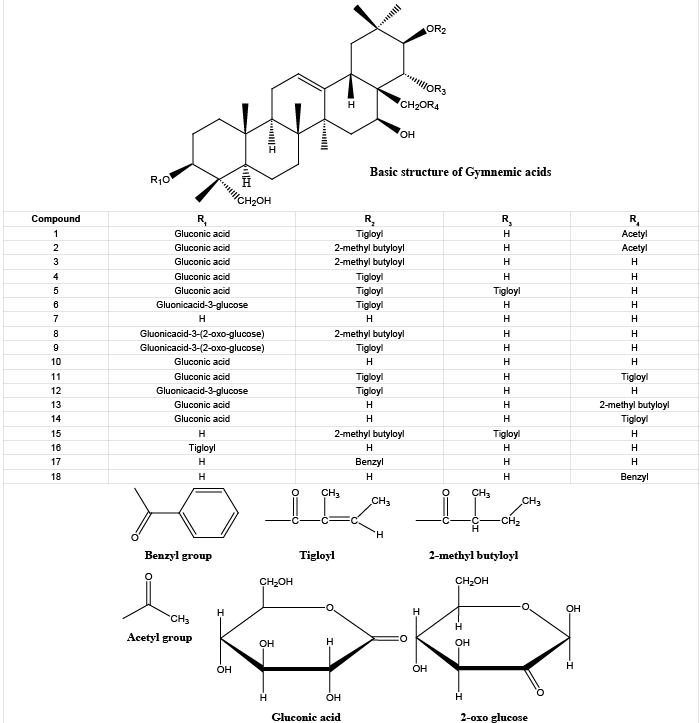 |
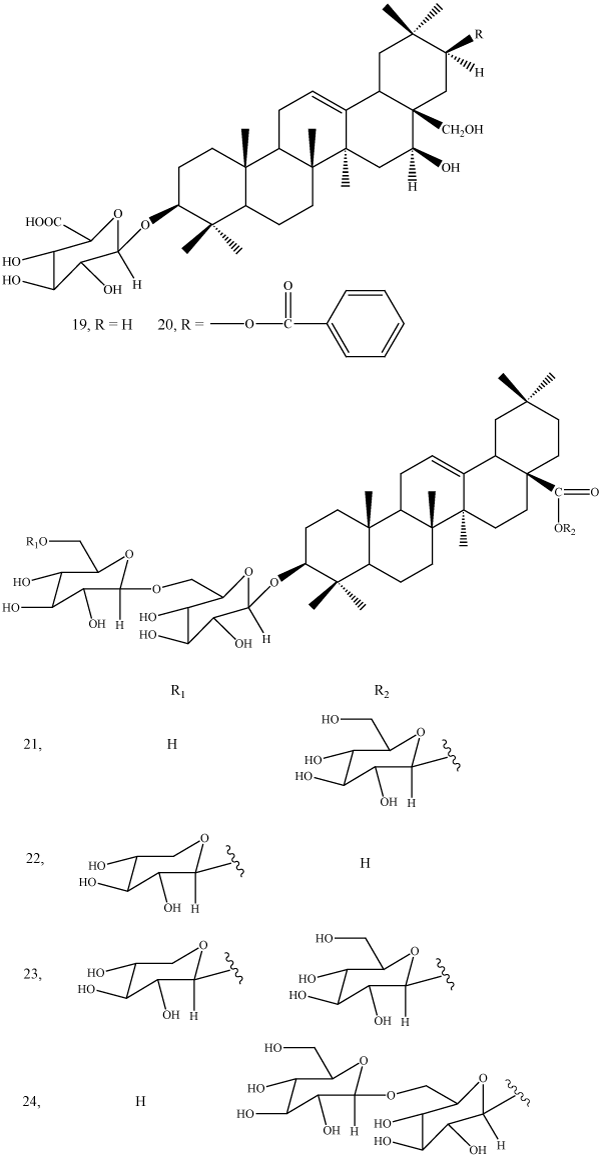 |
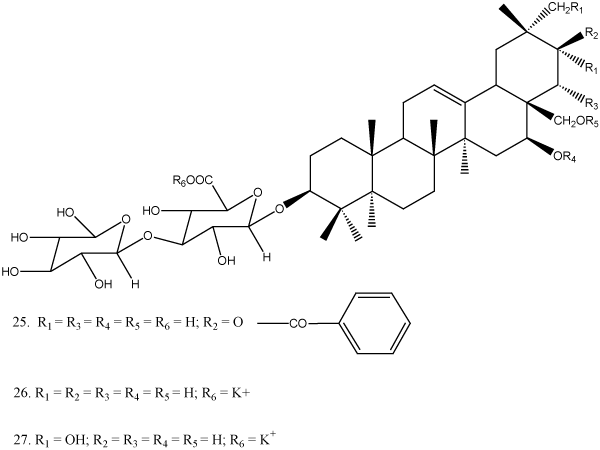 |
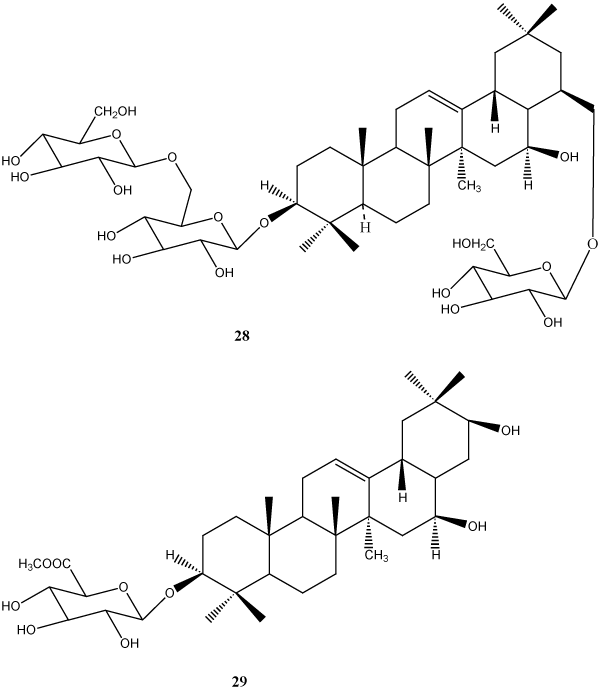 |
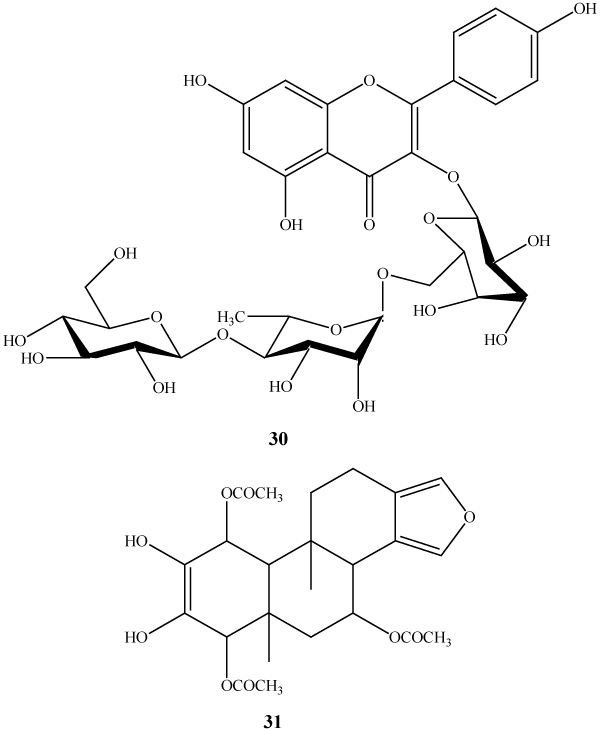 |
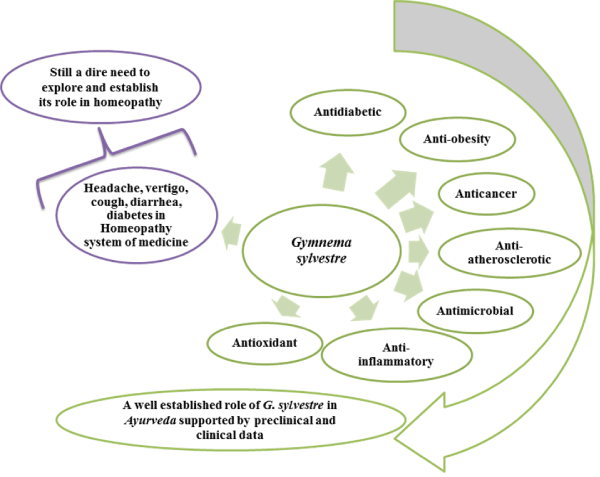 |
| Figure 1 | Figure 2 | Figure 3 | Figure 4 | Figure 5 | Figure 6 |
Relevant Topics
- Acupuncture Therapy
- Advances in Naturopathic Treatment
- African Traditional Medicine
- Australian Traditional Medicine
- Chinese Acupuncture
- Chinese Medicine
- Clinical Naturopathic Medicine
- Clinical Naturopathy
- Herbal Medicines
- Holistic Cancer Treatment
- Holistic health
- Holistic Nutrition
- Homeopathic Medicine
- Homeopathic Remedies
- Japanese Traditional Medicine
- Korean Traditional Medicine
- Natural Remedies
- Naturopathic Medicine
- Naturopathic Practioner Communications
- Naturopathy
- Naturopathy Clinic Management
- Traditional Asian Medicine
- Traditional medicine
- Traditional Plant Medicine
- UK naturopathy
Recommended Journals
Article Tools
Article Usage
- Total views: 25763
- [From(publication date):
December-2014 - Jul 01, 2025] - Breakdown by view type
- HTML page views : 20821
- PDF downloads : 4942
